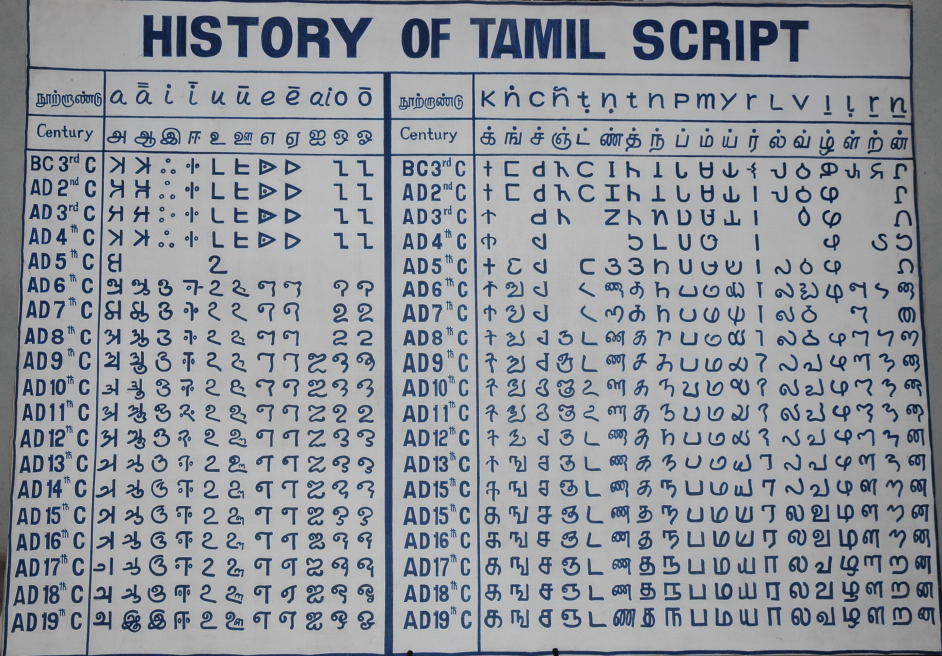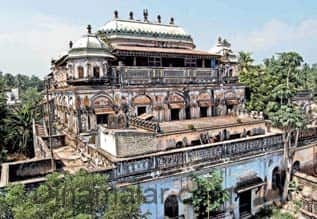 |
| Adinatha Font Picture Courtesy: Virtual Vinod |
 |
| History of Tamil Script Wikipedia |
Brahmi Unicode and digitization
'Unicode Character Standard provides (encoding) a unique number for every character, no matter what the platform, no matter what the program, no matter what the language.' This computer industry encoding standard encodes scripts rather than language. To be precise, 'more than one language shares a set of symbols that have historically related derivation, the union of the set of symbols of each such language is unified into a single collection identified in a single script.' The Unicode (the "Universal Alphabet") Consortium, a non-profit, charitable organization which develops, maintains and promotes the software internationalization standards and data, particularly the Unicode Standard. The Consortium works closely with W3C and ISO. The latest electronic version of the Unicode Standard is Version 7.0. This standard specifies the representation of texts in modern software products and standards.
There are the collection of symbols (i.e., scripts serving as inventories of symbols) drawn to write Brahmi. Brahmi was added to the Unicode standard in October 2010 with the release of version 6.0. There is an Unicode Block U+11000–U+1107F specifically developed for Brahmi which lies within Supplementary Multilingual plane. Since from August 2014 two free licence (the Open Font Licence) fonts that support Brahmi are made available: 1. Noto Sans Brahmi from Google which covers all characters; 2. Adinatha which only covers Tamil Brahmi (dialect of Brahmi)
Three Tamil epigraphy enthusiasts namely S/shri Shriramana Sharma Vinod Rajan and Udhaya Sankar have undertaken and brought out the free license Tamil Brahmi font to encourage its utilization among academicians, researchers and professionals as well as to promote its use and (computer) application in epigraphy and digitization. The team of researchers have worked out Adinatha within the Unicode Block U+11000–U+1107F specifically developed for Brahmi. They have imbibed from Early Tamil Epigraphy, the classic work by Iravatham Mahadevan for the shapes of glyphs.
The font is named after Adinatha, the first of the twenty-four tirthankaras who founded the Jainism philosophies and teachings. Only Jain Munis are credited for ushering Brahmi in ancient Tamilakam and applied Brahmi script to document and communicate with the rest of the world. Hence the Jain Munis are bestowed with honor and respect. Since the Unicode font includes both OpenType & Graphite table, they will promote digitization of the inscriptions in Tamil Brahmi in a wide variety of systems . The font package also includes an AAT version for compatibility with OS X applications that do not support OpenType. NHM Writer 2.0 renders software support to Tamil Brahmi.
History of Brahmi and Tamil Brahmi Scripts
The earliest script used in India was Brahmi. The best known inscriptions in Brahmi script are the lithic inscriptions of Ashoka (269 - 232 B.C. ruled over 37 years) discovered in the north central India dated to 3rd - 4th century B.C. The script was used to inscribe edicts in Prakrit language by the Mauryan ruler. As viewed by Iravatham Mahadevan, the Brahmi script was used in Andhra and Karnataka regions as well as in Tamilakam during 3rd century B.C. when Jain and Buddhist monks migrated to the Southern parts of India. Tamil Brahmi is the script variant (dialect) of the Brahmi script (Southern Brahmic alphabet) used in South India to write in Tamil, the language of administration in Tamilakam. Tamils have adopted the Brahmi script to suit the phonetic system of Tamil language and proscribed the imposition of Prakrit language.
Inscriptions in rock shelters and caves near Madurai were the earliest breakthrough. 'Dates for Tamil-Brahmi as early as the 6th century have been claimed, but all dates before the 3rd century are uncertain or controversial.' Scholars like Iravatham Mahadevan and Y. Subbarayalu hold the view that Tamil-Brahmi was introduced in Tamil Nadu after 3rd century B.C. Few others like K.V. Ramesh, retired Director of Epigraphy, Archaeological Survey of India (ASI) deliberate the period as Pre-Asokan.
The term `Tamil-Brahmi' is used when the script is in Brahmi but the language is Tamil. The Brahmi script was predominantly used for Prakrit from the Mauryan (Asokan) period. The Brahmi script was brought to the Tamil country in the third century B.C. by the Jain and Buddhist monks during the post-Asokan period.
The three more recent excavations in different places of Tamil Nadu have reignited debate on the date of Brahmi : 1. Urn with human skeleton in it along with miniature pots and Tamil-Brahmi in a rudimentary form inside an urn were discovered at the Iron Age burial site at Adichanallur in 2005; 2. A cist-burial excavated in 2009 at Porunthal village, 12 km from Palani in Tamil Nadu 3. Kodumanal excavation, near Erode more than 20 pot-sherds with Tamil-Brahmi inscriptions were found in 2012. There are contentious views regarding the origin of Tamil Brahmi. Dr. Satyamurthy claims the Tamil Brahmi script discovered inside the urn at Adichanallur to 5th century B.C. Dr.Rajan considers the Porunthal Tamil script to 490 B.C. based on the paddy grain dating. The 20 pot-sherds with Tamil-Brahmi inscriptions excavated at Kodumanal also the team of three scholars including Dr.Rajan arrive at similar views.
Reference
The earliest script used in India was Brahmi. The best known inscriptions in Brahmi script are the lithic inscriptions of Ashoka (269 - 232 B.C. ruled over 37 years) discovered in the north central India dated to 3rd - 4th century B.C. The script was used to inscribe edicts in Prakrit language by the Mauryan ruler. As viewed by Iravatham Mahadevan, the Brahmi script was used in Andhra and Karnataka regions as well as in Tamilakam during 3rd century B.C. when Jain and Buddhist monks migrated to the Southern parts of India. Tamil Brahmi is the script variant (dialect) of the Brahmi script (Southern Brahmic alphabet) used in South India to write in Tamil, the language of administration in Tamilakam. Tamils have adopted the Brahmi script to suit the phonetic system of Tamil language and proscribed the imposition of Prakrit language.
Inscriptions in rock shelters and caves near Madurai were the earliest breakthrough. 'Dates for Tamil-Brahmi as early as the 6th century have been claimed, but all dates before the 3rd century are uncertain or controversial.' Scholars like Iravatham Mahadevan and Y. Subbarayalu hold the view that Tamil-Brahmi was introduced in Tamil Nadu after 3rd century B.C. Few others like K.V. Ramesh, retired Director of Epigraphy, Archaeological Survey of India (ASI) deliberate the period as Pre-Asokan.
The term `Tamil-Brahmi' is used when the script is in Brahmi but the language is Tamil. The Brahmi script was predominantly used for Prakrit from the Mauryan (Asokan) period. The Brahmi script was brought to the Tamil country in the third century B.C. by the Jain and Buddhist monks during the post-Asokan period.
The three more recent excavations in different places of Tamil Nadu have reignited debate on the date of Brahmi : 1. Urn with human skeleton in it along with miniature pots and Tamil-Brahmi in a rudimentary form inside an urn were discovered at the Iron Age burial site at Adichanallur in 2005; 2. A cist-burial excavated in 2009 at Porunthal village, 12 km from Palani in Tamil Nadu 3. Kodumanal excavation, near Erode more than 20 pot-sherds with Tamil-Brahmi inscriptions were found in 2012. There are contentious views regarding the origin of Tamil Brahmi. Dr. Satyamurthy claims the Tamil Brahmi script discovered inside the urn at Adichanallur to 5th century B.C. Dr.Rajan considers the Porunthal Tamil script to 490 B.C. based on the paddy grain dating. The 20 pot-sherds with Tamil-Brahmi inscriptions excavated at Kodumanal also the team of three scholars including Dr.Rajan arrive at similar views.
Reference
- 2200- year-old Tamil-Brahmi inscription found on Samanamalai T.S.Subramanian. The Hindu March 24, 2012
- Adinatha Tamil Brahmi Font in Virtual Vinod. http://www.virtualvinodh.com/wp/tamil-brahmi-font/
- Brahmi (Unicode Consortium) http://www.unicode.org/charts/PDF/U11000.pdf
- Brahmi Script (Wikipedia)
- Is Tamil-Brahmi pre-Asokan? http://varnam.nationalinterest.in/2011/08/is-tamil-brahmi-pre-asokan/
- NHM Writer 2.0 http://software.nhm.in/products/writer
- Palani excavation triggers fresh debate TS Subramanian August 29, 2011 http://www.thehindu.com/news/national/tamil-nadu/article2408091.ece
- Porunthal excavations prove existence of Indian scripts in 5th century BC: expert. Kavita Kishore. The Hindu. October 15, 2011. http://www.thehindu.com/news/national/tamil-nadu/porunthal-excavations-prove-existence-of-indian-scripts-in-5th-century-bc-expert/article2538550.ece
- Rudimentary Tamil-Brahmi script' unearthed at Adichanallur T.S.Subramanian. The Hindu February 17, 2005. http://www.thehindu.com/2005/02/17/stories/2005021704471300.htm
- Tamil Brahmi in Virtual Vinod. http://www.virtualvinodh.com/wp/tamil-brahmi-lipi/
- Tamil Brahmi (Wikipedia)
- Tamil-Brahmi script found in village. T..Subramanian. June 28, 2009. ww.thehindu.com/todays-paper/tamilbrahmi-script-found-in-village/article271194.ece
- Tissamaharama Tamil Brahmi inscription (Wikipedia)
- Unicode (Wikipedia)























